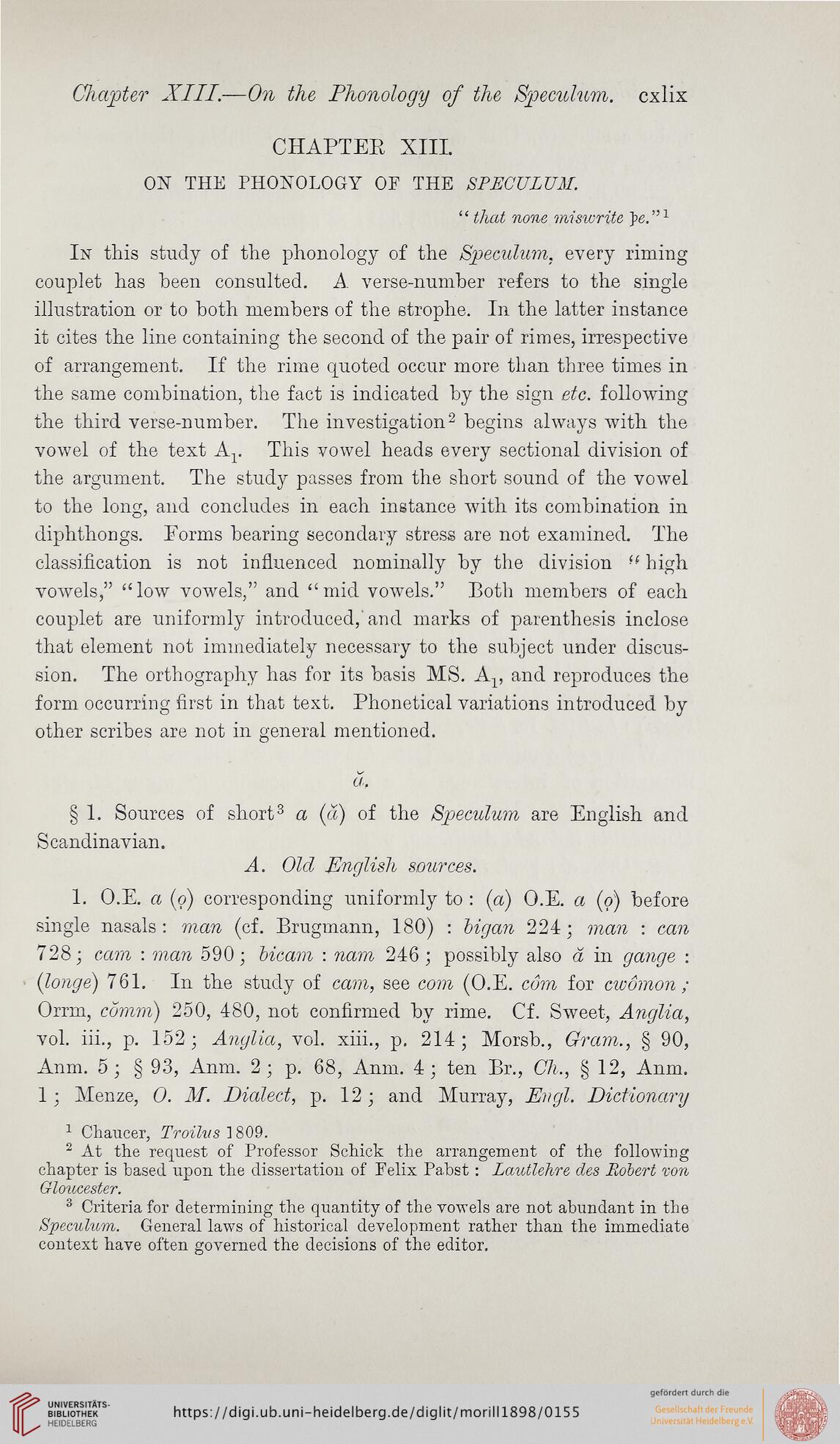Chapter XIII—On the Phonology of the Speculum, cxlix
CHAPTER XIII.
ON THE PHONOLOGY OF THE SPECULUM.
“ that none miswrite fe.”1
In this study of the phonology of the Speculum, every riming
couplet has been consulted. A verse-number refers to the single
illustration or to both members of the strophe. In the latter instance
it cites the line containing the second of the pair of rimes, irrespective
of arrangement. If the rime quoted occur more than three times in
the same combination, the fact is indicated by the sign etc. following
the third verse-number. The investigation2 begins always with the
vowel of the text Ax. This vowel heads every sectional division of
the argument. The study passes from the short sound of the vowel
to the long, and concludes in each instance with its combination in
diphthongs. Forms bearing secondary stress are not examined. The
classification is not influenced nominally by the division ■■ high
vowels,” “low vowels,” and “mid vowels.” Both members of each
couplet are uniformly introduced,'and marks of parenthesis inclose
that element not immediately necessary to the subject under discus-
sion. The orthography has for its basis MS. Ax, and reproduces the
form occurring first in that text. Phonetical variations introduced by
other scribes are not in general mentioned.
a,
§ 1. Sources of short3 a (a) of the Speculum are English and
Scandinavian.
A. Old English sources.
1. O.E. a (p) corresponding uniformly to : (a) O.E. a (d) before
single nasals: man (cf. Brugmann, 180) : bigan 224; man : can
728; cam : man 590; bicam : nam 246; possibly also a in gangs :
(long!) 761. In the study of cam, see com (O.E. com for cwomon ;
Orrm, comm} 250, 480, not confirmed by rime. Cf. Sweet, Anglia,
vol. iii., p. 152 ; Anglia, vol. xiii., p. 214 ; Morsb., Gram., § 90,
Anm. 5; § 93, Anm. 2; p. 68, Anm. 4; ten Br., Ch., § 12, Anm.
1; Menze, O. M. Dialect, p. 12; and Murray, Engl. Dictionary
1 Chaucer, Troilus 1809.
2 At the request of Professor Schick the arrangement of the following
chapter is based upon the dissertation of Felix Pa.bst: Lautlehre des Robert von
Gloucester.
3 Criteria for determining the quantity of the vowels are not abundant in the
Speculum. General laws of historical development rather than the immediate
context have often governed the decisions of the editor.
CHAPTER XIII.
ON THE PHONOLOGY OF THE SPECULUM.
“ that none miswrite fe.”1
In this study of the phonology of the Speculum, every riming
couplet has been consulted. A verse-number refers to the single
illustration or to both members of the strophe. In the latter instance
it cites the line containing the second of the pair of rimes, irrespective
of arrangement. If the rime quoted occur more than three times in
the same combination, the fact is indicated by the sign etc. following
the third verse-number. The investigation2 begins always with the
vowel of the text Ax. This vowel heads every sectional division of
the argument. The study passes from the short sound of the vowel
to the long, and concludes in each instance with its combination in
diphthongs. Forms bearing secondary stress are not examined. The
classification is not influenced nominally by the division ■■ high
vowels,” “low vowels,” and “mid vowels.” Both members of each
couplet are uniformly introduced,'and marks of parenthesis inclose
that element not immediately necessary to the subject under discus-
sion. The orthography has for its basis MS. Ax, and reproduces the
form occurring first in that text. Phonetical variations introduced by
other scribes are not in general mentioned.
a,
§ 1. Sources of short3 a (a) of the Speculum are English and
Scandinavian.
A. Old English sources.
1. O.E. a (p) corresponding uniformly to : (a) O.E. a (d) before
single nasals: man (cf. Brugmann, 180) : bigan 224; man : can
728; cam : man 590; bicam : nam 246; possibly also a in gangs :
(long!) 761. In the study of cam, see com (O.E. com for cwomon ;
Orrm, comm} 250, 480, not confirmed by rime. Cf. Sweet, Anglia,
vol. iii., p. 152 ; Anglia, vol. xiii., p. 214 ; Morsb., Gram., § 90,
Anm. 5; § 93, Anm. 2; p. 68, Anm. 4; ten Br., Ch., § 12, Anm.
1; Menze, O. M. Dialect, p. 12; and Murray, Engl. Dictionary
1 Chaucer, Troilus 1809.
2 At the request of Professor Schick the arrangement of the following
chapter is based upon the dissertation of Felix Pa.bst: Lautlehre des Robert von
Gloucester.
3 Criteria for determining the quantity of the vowels are not abundant in the
Speculum. General laws of historical development rather than the immediate
context have often governed the decisions of the editor.




